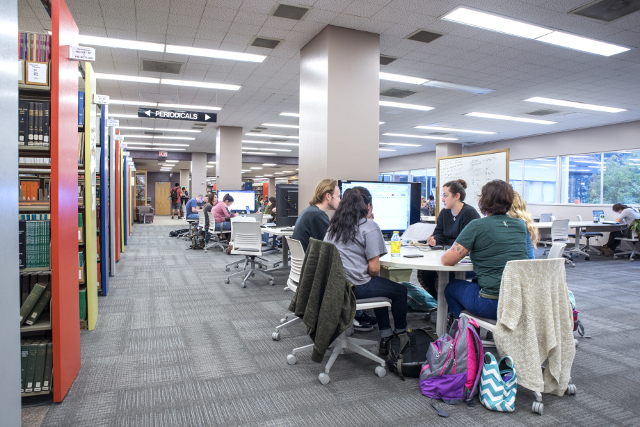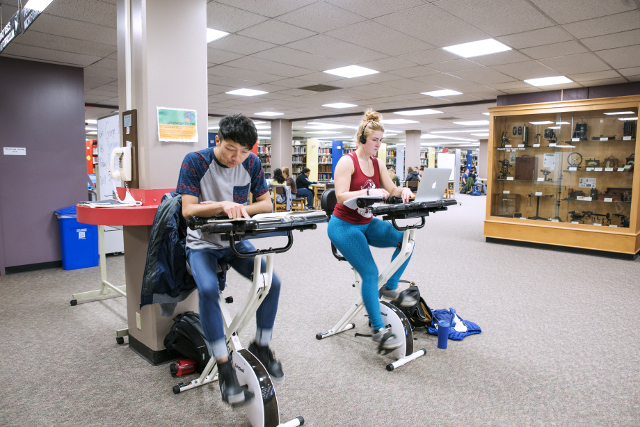
The Library has been undergoing a years-long makeover to inspire collaborative learning, research, and creativity for students and faculty.The modernization of the Library began in 2009 when the Library café opened. Five years later, books, documents, and journals were relocated to free up space for new study areas. And in 2015 HSU began the first phase of a massive seismic retrofitting project, which includes structural improvements to the Theatre Arts building and other facilities. Library construction is expected to wrap up sometime this year.
Library Dean Cyril Oberlander saw the recent improvements project as an opportunity to reimagine how space is used.
“Roughly 195,000 of the 500,000 books in circulation haven’t been checked out for over 15 years – or ever – and older industrial furniture no longer supports the needs of today’s students,” says Oberlander. “We are adding new technology and services, contemporary furniture, and open seating—all to enhance learning.”
The point is to get people talking.
“The more lively you make the library, the more welcoming the space,” says Oberlander. “That allows students to explore together, take risks and share together, and to learn together. These are forms of deeper learning.”
That’s exactly what’s happening. On any given day last semester, the Library has taken on the creative vibe of a Silicon Valley startup.
Students at the Library café bistro tables have noses in laptops and headphones in ears. Nearby, drawings of molecular bonds and arrows cover whiteboards. Most noticeable is the lively discussions and laughter from students clustered around giant computers at workstations and other sections of the library.

Library In the Time of Transformation
The first university library is thought to have been the Buddhist Takshila (Takshashila or Taxila) University, built around 600 B.C. in what is now Pakistan, according to the American Library Association. Originally, academic libraries in the United States had one purpose—house printed material in what could be considered bleak digs today, according to library planning and design expert Geoffrey T. Freedman. In Freedman’s words, they were “dim and confining” and “difficult to navigate.” And they stayed that way for decades.
The 21st Century saw changes in technology and classroom pedagogy—with a focus more on group projects—transforming the library’s role in academia and interior spaces, according to Irene M. H. Herold, president of the Association of Colleges and Research Libraries.
“They don’t just house what’s been published. They help students connect with knowledge so students and researchers can create new knowledge,” she says.
Enter “collaborative spaces,” a buzzword for common areas. Often equipped with computers or other technology, collaborative spaces are designed to accommodate group work and inspire students to explore ideas.
Space Age
Many universities in the United States have embraced more creative uses of spaces. According to Herold, Ithica College in New York was among the first colleges to install multimedia tables and open areas. The newly renovated science library at the University of Oregon features different learning rooms for different branches of sciences, each equipped with technology designed for those disciplines.
In other words, the former repository of printed material has become a living lab—a prominent theme of the HSU Library upgrades, providing opportunities to explore, create, innovate, and problem-solve.
On the first floor alongside the writing center are the math and computer labs. Together they form the Learning Commons. The nearby Digital Media Lab lets students check out tech equipment such as digital cameras and offers access to computers and software needed to build websites, edit video, and design magazines.
Library staff, like Library assistant and intern Victoria Bruner (’16 Social Work), are also on hand to teach students how to use the equipment. The new Humboldt Scholars Lab features workstations with new tables, chairs, and computers. It provides new publishing and digital services, including Humboldt State University Press. Workstations have been installed in other areas, as well. All are available to students for free.
No lab is complete without whiteboards, and now 70 of them are scattered throughout the library. The colorful scrawl adds a touch of color and creative madness to the mix.
“Wherever there’s a white board people will cover it with fun things,” says Bruner, who is now in the MBA program. “The drawings will be about biology or chemistry – classes I’ve never taken but I get to be part of them by walking around and observing.”
The open seating, workstations, and large screen computers are welcome additions for students like Taylor McKeand. The Forestry major likes the Library’s new look and feel, especially for group projects.
“This is a really great setup,” says McKeand. She and other Forestry majors at a Scholars Lab workstation are huddled around a computer to review their dendrology study guide. “I think these open spaces are a better choice for groups that talk loud.”
Kyle Mann, also in McKeand’s study group, finds the lively atmosphere conducive for staying awake. “If you’re studying at home it’s easy to do things besides your work, like fall asleep or watch cat videos.”
No cat videos or napping in the Scholars Lab; instead, a burst of applause within earshot of McKeand’s group. The accolades are from Jim Graham’s Geographic Information Systems (GIS) 470 class. Using the built-in overhead projector, his undergraduate students are presenting final projects to their classmates and others who happen to be walking by.
From Graham’s perspective, presentations outside the confines of a traditional classroom tend to raise the bar for students.
“They struggle with presentations to larger groups –something they’ll need to do in their careers,” says Graham, professor of Environmental Science & Management. “Presenting in a more public space gives them that practice, and I’ve found the pressure improves the quality of their work.”

Silence Still Golden
Scenes like these demonstrate how the library has become a hot spot. With approximately 5,000 visits each day, it has become a place to see and be seen.
“Rather than isolating people in study carrels, the social learning landscape of the library encourages connections,” says Oberlander. “A student writing an equation on a whiteboard might be asked by another student how that problem was solved. Connecting people is the whole point of open spaces. You’re trying to enhance collaboration to share expertise.”
Of course, the Library is a library, and it still embraces various forms of silence, including mental stillness. Hoping to encourage students to take a mental break, the Library has also created the Brain Booth, a pair of classrooms equipped with biofeedback machines for monitoring stress levels, sound machines, and even coloring books for grown-ups.
Silence has not entirely gone the way of the study carrel. Students can find large quiet zones on the second and third floors. The Library offers noise-cancelling headphones and earplugs available at the Library come in handy, especially as exterior seismic renovations enter the final phase.
For the “authentic” library experience, Psychology major Cohen Price and students like him retreat to the silent safe havens. “It can get noisy so I’ll go sit in the corner. I sometimes listen to music, but I mostly like silence.”
Learn more about the Library’s transformation at library.humboldt.edu/transforming.html